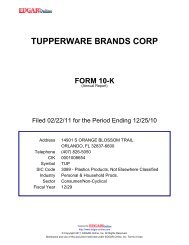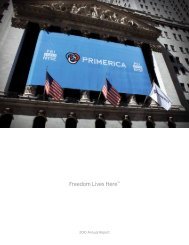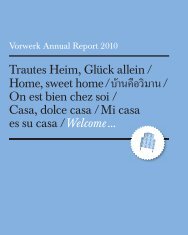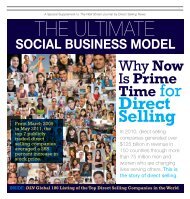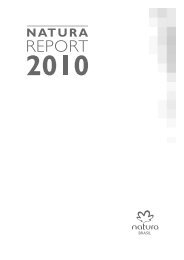Nu Skin 2010 Annual Report - Direct Selling News
Nu Skin 2010 Annual Report - Direct Selling News
Nu Skin 2010 Annual Report - Direct Selling News
You also want an ePaper? Increase the reach of your titles
YUMPU automatically turns print PDFs into web optimized ePapers that Google loves.
NU SKIN ENTERPRISES, INC.<br />
Notes to Consolidated Financial Statements<br />
RECENT ACCOUNTING PRONOUNCEMENTS<br />
In January <strong>2010</strong>, the Financial Accounting Standards Board issued<br />
guidance to amend the disclosure requirements related to recurring<br />
and nonrecurring fair value measurements. The guidance requires<br />
new disclosures on the transfers of assets and liabilities<br />
between Level 1 (quoted prices in active market for identical assets or<br />
liabilities) and Level 2 (significant other observable inputs) of the fair<br />
value measurement hierarchy, including the reasons and the timing of<br />
the transfers. Additionally, the guidance requires a roll forward of activities<br />
on purchases, sales, issuance, and settlements of the assets<br />
and liabilities measured using significant unobservable inputs (Level<br />
3 fair value measurements). The guidance became effective for the<br />
Company with the reporting period beginning January 3, <strong>2010</strong>, except<br />
for the disclosure on the roll forward activities for Level 3 fair<br />
value measurements, which will become effective for the Company<br />
with the reporting period beginning January 1, 2011. Adoption of this<br />
new guidance will not have a material impact on the Company’s unaudited<br />
condensed consolidated financial statements.<br />
During the first quarter of <strong>2010</strong>, the Company adopted new accounting<br />
guidance issued by the Financial Accounting Standards<br />
Board (“FASB”) related to transfers of financial assets. This guidance<br />
modifies the requirements for derecognizing financial assets from a<br />
transferor’s balance sheet and requires additional disclosures about<br />
transfers of financial assets and any continuing involvement by the<br />
transferor. The new guidance did not have a significant impact on the<br />
Company’s operating results, financial condition or disclosures.<br />
In October 2009, the FASB issued amendments to the criteria<br />
for separating consideration in multiple-deliverable arrangements.<br />
These amendments will establish a selling price hierarchy for determining<br />
the selling price of a deliverable. The amendments will require<br />
that a vendor determine its best estimate of selling price in a manner<br />
that is consistent with that used to determine the price to sell the deliverable<br />
on a standalone basis. These amendments will eliminate the<br />
residual method of allocation and require that arrangement consideration<br />
be allocated at the inception of the arrangement to all deliverables<br />
using the relative selling price method. These amendments will<br />
expand disclosures related to vendor’s multiple-deliverable revenue<br />
arrangements. These amendments will be effective for the Company’s<br />
fiscal 2011 year end. The Company is currently evaluating the<br />
impact these amendments will have on its consolidated financial<br />
statements and disclosures.<br />
In June 2009, the FASB amended the consolidation accounting<br />
guidance. Effective January 1, <strong>2010</strong>, the Company is are required to<br />
qualitatively assess the determination of its being the primary beneficiary<br />
(“consolidator”) of a variable interest entity (“VIE”) on whether<br />
it (1) has the power to direct matters that most significantly impact<br />
the activities of the VIE, and (2) has the obligation to absorb losses or<br />
the right to receive benefits of the VIE that could potentially be significant<br />
to the VIE. It also requires an ongoing reconsideration of the<br />
primary beneficiary and amends events that trigger a reassessment<br />
of whether an entity is a VIE. The new model is applicable to all new<br />
and existing VIEs. The adoption of this new guidance on January 1,<br />
<strong>2010</strong>, had no impact on the Company’s consolidated financial position<br />
or results of operation.<br />
In June 2009, the FASB amended the accounting guidance for<br />
determining whether a transfer of a financial asset qualifies for sale<br />
accounting. The amended guidance also provided four broad disclosure<br />
objectives designed to provide users of the financial statements<br />
with an understanding of.<br />
• the transferor’s continuing involvement with the transferred assets;<br />
• the nature of any restrictions on the transferor’s assets that relate<br />
to a transferred financial asset, including the carrying<br />
amount of those assets;<br />
• how servicing assets and servicing liabilities are reported by the<br />
transferor; and<br />
• how a transfer of financial assets affects the company’s balance<br />
sheet, earnings and cash flows.<br />
The prospective adoption of this guidance to new transfers of<br />
financial assets beginning January 1, <strong>2010</strong>, had no impact on the<br />
Company’s consolidated financial position or results of operation.<br />
3. RELATED PARTY TRANSACTIONS<br />
The Company leased corporate office and warehouse space<br />
from two entities that are owned by certain officers and directors of<br />
the Company. Total lease payments to these two affiliated entities<br />
were $3.8 million, $3.9 million and $3.6 million for the years ended<br />
December 31, 2008, 2009 and <strong>2010</strong>. On December 30, <strong>2010</strong>, the<br />
Company purchased the corporate office and warehouse space from<br />
59



